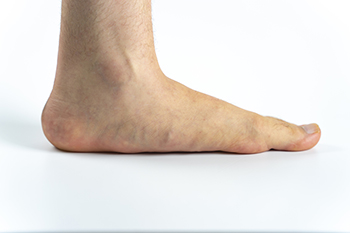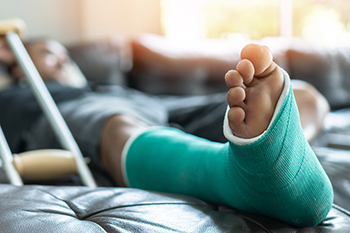

Corns are thickened areas of skin that can occur on the feet due to friction or pressure. They develop naturally to help protect the skin underneath them. They are commonly seen on the tops and sides of the toes and the balls of the feet. Corns can be hard and dry or soft and mushy. Corns can be caused by arthritis or poorly fitting shoes. Home treatment of corns usually consists of soaking the affected foot in warm water until the skin softens, and then gently filing the corn down with a pumice stone. One needs to use care when with this process and be sure to not press too hard to avoid bleeding and possible infection. Adding a donut-shaped adhesive pad around the corn can help the corn from touching the inside of the shoe. Routine foot care, including moisturizing the feet and keeping the toenails trimmed properly, are good preventative measures. If you are not sure why you have developed a corn, it becomes painful, or is not healing properly, see a podiatrist for treatment.
Corns can make walking very painful and should be treated immediately. If you have questions regarding your feet and ankles, contact Dr. Larry Cohen of New York City. Our doctor will treat your foot and ankle needs.
Corns: What Are They? And How Do You Get Rid of Them?
Corns are thickened areas on the skin that can become painful. They are caused by excessive pressure and friction on the skin. Corns press into the deeper layers of the skin and are usually round in shape.
Ways to Prevent Corns
There are many ways to get rid of painful corns such as:
Treating Corns
Although most corns slowly disappear when the friction or pressure stops, this isn’t always the case. Consult with your podiatrist to determine the best treatment option for your case of corns.
If you have any questions please feel free to contact our offices located in Midtown, Manhattan New York, NY . We offer the newest diagnostic and treatment technologies for all your foot and ankle needs.

The foot condition referred to as plantar fasciitis can cause severe heel pain. It affects the plantar fascia, which is the band of tissue that connects the heel to the toes, and is located on the sole of the foot. Repetitive running and overuse may cause the plantar fascia to become inflamed or torn, and this often requires medical attention. Many patients notice the pain is worse in the morning after arising, and may become milder as the foot warms up while walking. This condition may occur from standing on hard or uneven surfaces for most of the day, or possibly from wearing shoes that have little or no support. Mild relief may be found when custom-made orthotics are worn, and this may help to take pressure off of the plantar fascia. If you have heel pain, it is strongly advised that you are under the care of a podiatrist who can effectively diagnose and properly treat plantar fasciitis.
Plantar fasciitis can be very painful and inconvenient. If you are experiencing heel pain or symptoms of plantar fasciitis, contact Dr. Larry Cohen from New York City. Our doctor can provide the care you need to keep you pain-free and on your feet.
What Is Plantar Fasciitis?
Plantar fasciitis is the inflammation of the thick band of tissue that runs along the bottom of your foot, known as the plantar fascia, and causes mild to severe heel pain.
What Causes Plantar Fasciitis?
How Can It Be Treated?
While very treatable, plantar fasciitis is definitely not something that should be ignored. Especially in severe cases, speaking to your doctor right away is highly recommended to avoid complications and severe heel pain. Your podiatrist can work with you to provide the appropriate treatment options tailored to your condition.
If you have any questions please feel free to contact our offices located in Midtown, Manhattan New York, NY . We offer the newest diagnostic and treatment technologies for all your foot and ankle needs.

Having flat feet is a foot condition that affects approximately 8 million people in the country. It is noticeable by the absence of an arch in the foot, and it can cause some people pain and discomfort. The majority of babies are born with flat feet, and the arch generally develops fully in the teenage years. Some adults will never have an arch, and this may affect certain parts of their lives. A common concern that is held by people who have flat feet and are interested in joining the military consists of being qualified for certain branches of service. In the past, military enlistment was not permitted for people with flat feet, but that policy has recently been changed. People who have this condition are allowed to enter the military, providing there are no obvious symptoms. However, if there is foot pain or swelling from flat feet, the interested person will be barred from enlisting. If you have questions about flat feet and how it contributes to enlisting in the military, please contact a podiatrist, who can answer any questions and concerns you may have.
Flatfoot is a condition many people suffer from. If you have flat feet, contact Dr. Larry Cohen from New York City. Our doctor will treat your foot and ankle needs.
What Are Flat Feet?
Flatfoot is a condition in which the arch of the foot is depressed and the sole of the foot is almost completely in contact with the ground. About 20-30% of the population generally has flat feet because their arches never formed during growth.
Conditions & Problems:
Having flat feet makes it difficult to run or walk because of the stress placed on the ankles.
Alignment – The general alignment of your legs can be disrupted, because the ankles move inward which can cause major discomfort.
Knees – If you have complications with your knees, flat feet can be a contributor to arthritis in that area.
Symptoms
Treatment
If you are experiencing pain and stress on the foot you may weaken the posterior tibial tendon, which runs around the inside of the ankle.
If you have any questions please feel free to contact our offices located in Midtown, Manhattan New York, NY . We offer the newest diagnostic and treatment technologies for all your foot and ankle needs.

A broken foot can wreak havoc in daily life and cause severe pain and discomfort. It can also make everyday tasks impossible to complete. Most broken feet occur from a fall as the foot may twist in a different direction than the rest of the body. Conversely, it may also happen gradually, and this may be referred to as a stress fracture. Common symptoms that many people experience with a broken foot can consist of a bone that may protrude through the skin appearing displaced, and the foot may immediately become bruised or swollen. It is difficult to walk and prompt medical attention is often sought. A proper diagnosis consists of having an X-ray taken and this is successful in determining the severity of the fracture. A cast or protective boot may be prescribed for approximately six weeks. If you have broken your foot, it is suggested that you speak to a podiatrist who can diagnose and treat it as quickly as possible.
A broken foot requires immediate medical attention and treatment. If you need your feet checked, contact Dr. Larry Cohen from New York City. Our doctor can provide the care you need to keep you pain-free and on your feet.
Broken Foot Causes, Symptoms, and Treatment
A broken foot is caused by one of the bones in the foot typically breaking when bended, crushed, or stretched beyond its natural capabilities. Usually the location of the fracture indicates how the break occurred, whether it was through an object, fall, or any other type of injury.
Common Symptoms of Broken Feet:
Those that suspect they have a broken foot shoot seek urgent medical attention where a medical professional could diagnose the severity.
Treatment for broken bones varies depending on the cause, severity and location. Some will require the use of splints, casts or crutches while others could even involve surgery to repair the broken bones. Personal care includes the use of ice and keeping the foot stabilized and elevated.
If you have any questions please feel free to contact our offices located in Midtown, Manhattan New York, NY . We offer the newest diagnostic and treatment technologies for all your foot and ankle needs.

As winter approaches, it can bring with it an increase in pain and inflammation in people with arthritis. This is believed to be caused by changes in barometric pressure rather than by cold and damp climates. When the barometer is up, the pressure pushes against the body and keeps tissues from expanding. The opposite is true when the barometer drops. The lower pressure allows the tissues to expand and they in turn put pressure on the nerves that transmit feelings of pain. This explains why many people with arthritis say they can predict a storm. They feel the pain as the barometer drops. Physical activity can help to reduce joint pain and increase flexibility. Experts suggest keeping active during colder months by walking indoors and wearing looser layers of clothing to trap body heat. Wearing socks and waterproof boots are recommended if you are outdoors. See a podiatrist for further information on how to manage your arthritis pain.
Arthritis can be a difficult condition to live with. If you are seeking treatment, contact Dr. Larry Cohen from New York City. Our doctor can provide the care you need to keep you pain-free and on your feet.
Arthritic Foot Care
Arthritis is a joint disorder that involves the inflammation of different joints in your body, such as those in your feet. Arthritis is often caused by a degenerative joint disease and causes mild to severe pain in all affected areas. In addition to this, swelling and stiffness in the affected joints can also be a common symptom of arthritis.
In many cases, wearing ill-fitting shoes can worsen the effects and pain of arthritis. Wearing shoes that have a lower heel and extra room can help your feet feel more comfortable. In cases of rheumatoid arthritis, the arch in your foot may become problematic. Buying shoes with proper arch support that contour to your feet can help immensely.
Alleviating Arthritic Pain
It is best to see your doctor for the treatment that is right for your needs and symptoms. Conditions vary, and a podiatrist can help you determine the right method of care for your feet.
If you have any questions, please feel free to contact our offices located in Midtown, Manhattan New York, NY . We offer the newest diagnostic tools and technology to treat your foot and ankle needs.